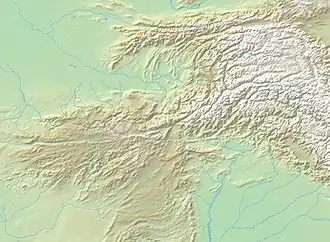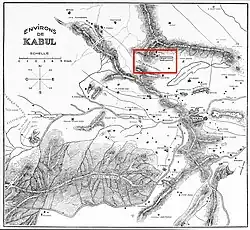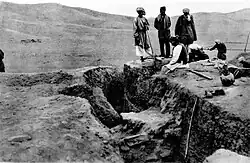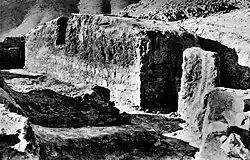Khair Khaneh
.jpg) | |
 Shown within West and Central Asia  Khair Khaneh (South Asia)  Khair Khaneh (Hindu-Kush)  Khair Khaneh (Afghanistan) | |
| Coordinates | 34°35′51″N 69°06′32″E / 34.597560°N 69.10902°E |
|---|---|
| Type | Brahmanical Temple |
Khair Khaneh is an archaeological site located near Kabul, Afghanistan that was excavated in the 1930s by Joseph Hackin.[5][6][7]
A Brahmanical Temple was excavated there. The construction of the Khair Khaneh temple itself is dated to 608-630 CE, at the beginning of the Turk Shahis period.[8] Most of the remains, including marble statuettes, date to the 7th–8th century, during the time of the Turk Shahi.[5][9][10]
A remarkable marble statue[11] of the solar deity in Hinduism, lord Surya, in tunic and boots was discovered in Khair Khaneh.[11] The statue is associated to the Turk Shahi period, when Hinduism was still a major religion in Afghanistan.[11]
-
 Map of Khair Khaneh, near Kabul
Map of Khair Khaneh, near Kabul -
 Khair Khaneh excavations in 1933
Khair Khaneh excavations in 1933 -
 Khair Khaneh ruins
Khair Khaneh ruins -
.jpg) Khair Khaneh sanctuary: a donor wearing a tunic, boots and a sword.
Khair Khaneh sanctuary: a donor wearing a tunic, boots and a sword. -
![Seated Avalokiteshvara, white marble, Khair Khaneh, 6th-7th century CE. Musée Guimet MA 8151.[12]](./_assets_/Seated_Avalokiteshvara%252C_white_marble%252C_Khair_Khaneh%252C_6th-7th_century_CE._Mus%C3%A9e_Guimet_MA_8151.jpg)
-
.jpg) Khair Khaneh sanctuary (reconstitution by Jean Carl)
Khair Khaneh sanctuary (reconstitution by Jean Carl)
References
- ^ "Recherches Archéologiques au Col de Khair khaneh près de Kābul : vol.1 / Page 77 (Grayscale High Resolution Image)". dsr.nii.ac.jp.
- ^ Dupree, Louis (14 July 2014). Afghanistan. Princeton University Press. p. 309. ISBN 978-1-4008-5891-0.
Khair Khaneh is situated in the pass separating the Kabul Valley from Kohistan (which includes Begram). Kushano–Sasanian and early Hindu art motifs mingle in a whitish-gray marble statue of the Sun God (either Surya or Mithra) seated on a ...
- ^ Adrych, Philippa; Bracey, Robert; Dalglish, Dominic; Lenk, Stefanie; Wood, Rachel (2017). Images of Mithra. Oxford University Press. ISBN 978-0-19-879253-6.
- ^ Journal of the American Oriental Society (Volumes 56-57 ed.). 1986.
To overcome the difficulty that Pingala wears a beard , the Kabirs had to be introduced , Great Gods of Samothrake who ... This feature brings the sun - god of Khair Khaneh as close as possible to the Iranian Mithras , who guides the soul of the ...
- ^ a b KUWAYAMA (Kyoto City University of Fine Arts), SHOSHIN (1975). "KHAIR KHANEH AND ITS CHINESE EVIDENCES". Orient. XI.
- ^ Kuwayama, Shoshin (1976). "The Turki Śāhis and Relevant Brahmanical Sculptures in Afghanistan" (PDF). East and West. 26 (3/4): 375–407. ISSN 0012-8376. JSTOR 29756318.
- ^ Hackin, Joseph (1936). Recherches Archéologiques au Col de Khair khaneh près de Kābul : vol.1 / Page 77 (Grayscale High Resolution Image). DAFA.
- ^ Kuwayama, Shoshin (1976). "The Turki Śāhis and Relevant Brahmanical Sculptures in Afghanistan". East and West. 26 (3/4): 407. ISSN 0012-8376.
- ^ Kuwayama, Shoshin (1976). "The Turki Śāhis and Relevant Brahmanical Sculptures in Afghanistan" (PDF). East and West. 26 (3/4): 375–407. ISSN 0012-8376.
- ^ Hackin, Joseph (1936). Recherches Archéologiques au Col de Khair khaneh près de Kābul : vol.1 / Page 77 (Grayscale High Resolution Image). DAFA.
- ^ a b c Kuwayama, Shoshin (1976). "The Turki Śāhis and Relevant Brahmanical Sculptures in Afghanistan". East and West. 26 (3/4): 405-407. ISSN 0012-8376. JSTOR 29756318.
It is not therefore possible to attribute these pieces to the Hindu Shahi period. They should be attributed to the Shahi period before the Hindu Shahis originated by the Brahman wazir Kallar, that is, the Turki Shahis. According to the above sources, Hinduism and Buddhism are properly supposed to have coexisted especially during the 7th-8th centuries A.D. just before the Muslim hegemony. The marble sculptures from eastern Afghanistan should not be attributed to the period of the Hindu Shahis but to that of the Turki Shahis.
- ^ De l'Inde au Japon, 10 ans d'acquisitions au musée Guimet. Musée Guimet. 2007. p. 14, item 27.